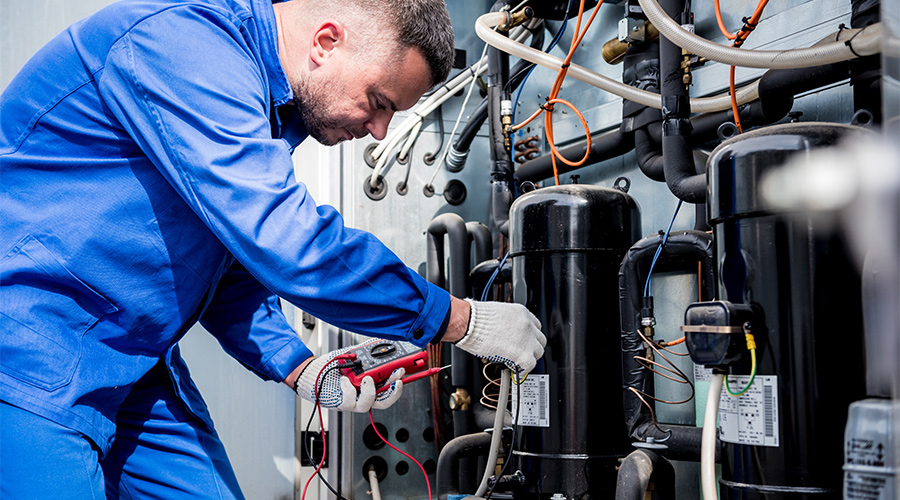Refrigerant Safety 101
Basic training in proper handling and disposal can prevent accidents, injuries and penalties
The U.S. Environmental Protection Agency (EPA) cites environmental preservation as its motivation for the high degree of regulation in the air conditioning industry. Following EPA refrigerant regulations responsibly will contribute to the reduction of an environmental threat and protect organizations from civil penalties of up to $32,500 per day per violation and criminal penalties of up to five years imprisonment.
For these reasons, it is important for engineering and maintenance managers that in-house service technicians and outside contractors working with refrigerants follow organizations’ written EPA policy and procedures. Well-defined procedures, appropriate equipment, and sufficient knowledge of refrigerants will reduce accidents and injuries on the job, and training can make sure organizations achieve these goals.
Training for Compliance
Although mandatory, safety and training are only parts of compliance. The EPA recommends that every organization designate a facility refrigerant compliance manager and implement a refrigerant compliance management plan. Producing a program that outlines organization-specific, written refrigeration regulations is the first step to effective compliance.
It should describe how EPA regulations fit into an organization’s work processes and should use flow charts and work statements to illustrate key points. The program also should define the organization’s specific policies and procedures for refrigerant handling, from purchase through final disposal.
Training is required within organizations to successfully implement an EPA refrigerant-management compliance program. A training program should ensure that everyone affected receives a copy of the compliance program and any other information needed to ensure success. The start of training is also a good time to reinforce management’s commitment to compliance.
Also, employees should sign a statement of understanding that compliance is a condition of their employment, and managers should include these requirements in contractor agreements. To maintain ongoing compliance, managers also should schedule regular compliance update training. This step will reinforce the importance of compliance and further demonstrate an organization’s intent to comply.
Integrating Safety
Section 608 of the Clean Air Act Amendments of 1990, as well as more recently proposed EPA amendments, require that technicians follow specific procedures while maintaining, servicing, repairing or disposing of air-conditioning or refrigeration equipment.
Technicians can prevent injuries and costly mistakes by consistently following defined procedures and using common sense when handling refrigeration equipment. Taking simple precautions can be a substantial leap toward industry-wide safety. Among the more obvious practices that should become habit for refrigerant technicians are these.
First, returnable cylinders must meet U.S. Department of Transportation (DOT) specifications and are characterized by a combined liquid/vapor valve located at the top. A returnable cylinder must never be filled above 80 percent of the container’s volume.
If cylinders will be exposed to temperatures above 130 degrees, technicians should not fill them more than 60 percent. Hydrostatic pressure can be deadly in an overfilled refrigerant container. While over-pressure safety devices provide some level of safety, they do not eliminate risk. An opened valve can spew refrigerant, or the entire tank might rupture with extreme violence.
Second, technicians should weigh and inspect cylinders carefully before filling. They also should:
-
not use cylinders that are dented, rusted, gouged or damaged in any way
-
examine the valve assembly for leakage, damage or tampering
-
handle cylinders carefully
-
store refrigerant cylinders in a vertical position with their valves at the top
-
become familiar with all pieces of recovery equipment
-
apply all methods and instruction prescribed by the system’s manual every time they use the equipment.
Disposable cylinders, which are constructed of common steel, can oxidize and become weakened by rust. As a result, their wall and seams no longer can tolerate pressure or contain gases. Technicians should discard rusted containers because they can never be used for recovery or refilling. To prevent corrosion, technicians should store containers in dry locations.
Cylinders with residual refrigerant should not be allowed to sit at a job site because saturated vapor pressure will form if even the smallest amount of liquid is present. Before discarding a container, technicians should recover any remaining refrigerant per EPA recovery efficiencies.
Third, technicians should collect used refrigerant in DOT-approved, refillable cylinders or drums, as appropriate, painted gray with the top shoulder portion painted yellow. They need to label the cylinder or container with a DOT four-by-four green, diamond-shaped, nonflammable gas label.
Finally, technicians must fill drums to allow vapor space equal to at least 10 percent of the drum height between the top of the liquid and the drum top. Refillable cylinders must be retested and recertified every five years, and the test date must be stamped on the cylinder shoulder. Retesting by visual inspection alone is not permitted.
Transporting and Transferring
In transporting used refrigerant, technicians need to clearly label its container with a DOT classification tag. When moving a cylinder, they must ensure that it is firmly strapped onto an appropriate wheeled device. Never roll a cylinder on its base or lay it down to roll it. Use a forklift truck to move half-ton containers of refrigerant.
When transferring refrigerant from containers or equipment, it is mandatory to avoid contamination or venting to the atmosphere. Containers must be the correct type and color and properly marked.
Any time a container or system undergoes the transfer of refrigerant, the technician must check it for refrigerant type, cleanliness and oils used. Also, the container used for holding transferred refrigerant must be evacuated, and under no circumstances should workers mix different refrigerants.
Technician Protection
Chlorofluorocarbons and hydrochlorofluorocarbons are heavier than air and will replace air in a confined space. This situation can lead to possible asphyxiation for anyone working in the space. Oxygen starvation is the leading cause of death in accidents involving a refrigerant.
Technicians must take extreme care to avoid direct ingestion of refrigerant vapors. If a spill occurs, they will need to put on a self-contained breathing apparatus or evacuate the area until it has been properly ventilated.
Also, careless handling of cylinders can result in sudden releases of refrigerant, which can cause frostbite, skin damage or blindness. To avoid these circumstances, workers should wear safety glasses with side shields or a full-face shield, safety shoes, hard hat, long pants, gloves and a long-sleeved shirt.
Workers can prevent accidents around hoses and extension cords by using proper barriers and signs. Use top-quality, properly attached hoses and lines, place them where risk is minimal, and inspect hose seals frequently. Wear butyl-lined gloves and safety glasses when working with hoses. Technicians also can enhance safety by:
-
ensuring that all power is disconnected and disabled to any equipment requiring recovery
-
locking out disconnects with approved lockout devices
-
opening valves slowly and knowing in advance if liquid vapor will be released
-
not plugging pressure-relief devices
-
never applying direct heat to a closed system that contains refrigerant.
Finally, installing refrigerant vapor sensors, an adjoining alarm system, ventilation piping leading from the purge units to the outside air, and ventilation exhaust fans can increase the safety of a system.
Mark Harbin is manager of the compliance services division, Environmental Support Solutions, www.ess-home.com. He is a Certified Environmental Auditor and a licensed contractor experienced in EPA Title VI refrigerant regulation compliance, DOT refrigerant cylinder safety requirements and OSHA safety standards for HVAC technicians.
Related Topics:











